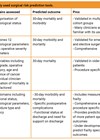Part 2 of this topic can be found here
Statement of the problem
Clinical frailty carries an increased risk of poor health outcomes. The pathological process resulting in frailty is often overlooked and elucidating its aetiology and natural history are pivotal in prevention and treatment [1].
The word frailty describes a decline in function throughout multiple systems of the human body [2]. One of the key aspects of its definition is an “individual’s vulnerability for developing increased dependency and / or mortality when exposed to a physiological or psychological stressor” [3], and therefore by definition, surgery places frail patients at a greater risk.
This is two-part feature on the frail urological patient – this article will outline the definition of clinical frailty, the issues in current practice and the impact in the urological patient. The next article will address the assessment, optimisation and surgical-decision making around the frail and high-risk patient in urology.
Definition
Clinical frailty as a concept was introduced to the geriatric medical literature almost three decades ago as a method of understanding the needs of complex elderly patients [3]. The definition and its assessment have been a topic of conversation in the scientific community [4]. The Frailty Index (FI) and the frailty phenotype [5] will be described.
The phenotypic model of frailty proposed by Fried in 2001 [6] includes: unintentional weight loss, exhaustion, low physical activity, slow walking speed and muscular weakness. Patients are grouped as either frail, pre-frail or non-frail based on quantity of characteristics [5].
The frailty index is a validated tool for diagnosis which views frailty as an accumulation of health deficits [5] – “the more individuals have wrong with them, the more likely they are to be frail” [6]. There is no defined age cut-off for frail patients, although much of the literature focuses on patients over the age of 65, after which prevalence starts to increase [7].
Age does not equate to frailty; its prevalence increases with age and is increasing worldwide, particularly in middle income countries [8]. One in five (12 million) of the English population are over 65 (18%) and this is expected to increase [9]. Recent data suggest that 8.1% of the over 50s are deemed clinically frail with “urban and coastal areas disproportionately frail relative to those in rural and inland areas” [9]. The demand for urological surgical intervention in the older population is growing [10] and it is estimated that two-thirds of urological inpatients are aged >65 years [11].
Frailty in urology patients
Emergency admissions
There is limited information surrounding the frailty status of emergency admission; the author’s pilot study suggests that the average age of a patient admitted as an emergency is 72 and the average clinical frailty score (CFS) is 4. This increases to 6 for those above 80 and is associated with an increase in length of stay. This correlates with published data [12].
The Clinical Frailty Scale [13] is validated by the National Institute for Health & Care Excellence (NICE) and is a “reliable predictor of outcomes in the urgent care context”. Developed by Professor Ken Rockwood it is used throughout the UK and North America; the details of the specific scoring systems will be explored in the next article. NICE suggests that in the acute setting, as the CFS increases, the rate of readmission, length of stay, morbidity and mortality all increase. The largest rise is observed between CFS 6 and 7, when mortality almost doubles from 6% to 11%. It is this group of patients where geriatric referral is recommended and restorative care should be considered post discharge; it is also these groups of patients that have the longest length of stay (LOS). Braude et al. [10] described the successful implementation of a ‘Proactive care of Older People undergoing Surgery (POPS) -Urology’ strategy which can reduce inpatient LOS. Here, they showed a reduction in LOS by 19% through targeted geriatrician-led ward rounds.
“Intuitively and based on the evolving demographic of the urological emergency patient, the proactive ‘uro-geriatrician’ may have a role in the future and address the wider holistic needs of elderly patients on our wards”
The impact of the introduction of an ortho-geriatric service for patients with hip fractures in the acute setting is well established and can reduce both in-hospital mortality and one-year mortality [14]. It is likely that further data are required to assess the impact of geriatric intervention following emergency urological admission. Intuitively and based on the evolving demographic of the urological emergency patient, the pro-active ‘uro-geriatrician’ may have a role in the future and address the wider holistic needs of elderly patients on our wards.
Elective surgery
The understanding of clinical frailty in the elective urology patient is becoming important – “frailty is an independent risk factor for morbidity, mortality, protracted length of stay and institutional discharge in several surgical populations” [15] and a timely frailty assessment may enhance the preoperative risk assessment of the urology patient. The various methods of frailty assessment preoperatively will be discussed in the next article.
Rosiello et al. [16] looked at frailty prevalence and short-term complications in patients undergoing radical nephro-ureterectomy and identified 16% of their population as frail. Over a 15-year period, they were operating on increased numbers of frail patients. The complication rate and in-hospital stay were higher in the frail, independent of age and other co-morbidity indices. Chappidi et al. found that with increasing frailty index scores, the risk of Clavien grade 4 or 5 complications increased after radical cystectomy and the frailty score was a predictor of outcome [17].

A large study highlighting the importance of assessing clinical frailty in patients prior to radical prostatectomy (RP) [18] demonstrated that 13% of the patient population were frail (which increased over time) and were at a higher risk of poor, short-term postoperative outcomes. This paper highlighted a key point, which is that there is sometimes little overlap between the classical indicators of fitness for surgery and clinical frailty. Frailty here was an independent predictor of overall complications (OR:1.95). Of those patients in this study deemed clinically frail, 85% of patients failed to fit into the BMI>30 or Charlson comorbidity index ≥2 risk category, “1.2% of RP patients were frail and also had BMI ≥30; moreover, only 0.5% were frail and also had CCI ≥2”.
It is therefore imperative that frailty is considered a separate metric in preoperative risk evaluation.
Concluding remarks
Clinical frailty is increasingly prevalent in the urological population. Understanding the concept and the risks associated with the diagnosis is important in risk stratification and management in the elective and emergency setting. More data are urgently required to understand the frailty burden in emergency admissions. In the next article, we will assess how frailty can be objectively measured and how intervention can mitigate risk.
References
1. Xue QL. The frailty syndrome: definition and natural history. Clinics in Geriatric Medicine 2011;27(1):1-15.
2 Kostakopoulos NA, Karakousis ND. Frailty assessment and postoperative complications in urologic oncology operations. Journal of Frailty, Sarcopenia and Falls 2020;5(3):57.
3. Church S, Rogers E, Rockwood K, Theou O. A scoping review of the Clinical Frailty Scale. BMC Geriatrics 2020;20(1):1-18.
4. Pilotto A, Custodero C, Maggi S, et al. A multidimensional approach to frailty in older people. Ageing Research Reviews 2020;60:101047.
5. Romero-Ortuno R. An alternative method for Frailty Index cut-off points to define frailty categories. European Geriatric Medicine 2013;4(5):299-303.
6. Fried LP, Tangen CM, Walston J, et al. Frailty in older adults: evidence for a phenotype. The Journals of Gerontology Series A: Biological Sciences and Medical Sciences 2001;56(3):M146-57.
7. Clegg A, Young J, Iliffe S, et al. Frailty in elderly people. The Lancet 2013;381(9868):752-62.
8. Siriwardhana DD, Hardoon S, Rait G, et al. Prevalence of frailty and prefrailty among community-dwelling older adults in low-income and middle-income countries: a systematic review and meta-analysis. BMJ Open 2018;8(3):e018195.
9. Sinclair DR, Maharani A, Chandola T, et al. Frailty among older adults and its distribution in England. The Journal of Frailty & Aging 2022;11(2):163-8.
10. Michalik C, Maciukiewicz P, Drewa T, et al. Frailty, geriatric assessment and prehabilitation in elderly patients undergoing urological surgery–is there a need for change of the daily clinical practice? Synthesis of the available literature. Central European Journal of Urology 2020;73(2):220.
11. Braude P, Goodman A, Elias T, et al. Evaluation and establishment of a ward‐based geriatric liaison service for older urological surgical patients: Proactive care of Older People undergoing Surgery (POPS)‐Urology. BJU International 2017;120(1):123-9.
12. Henderson J, Thilagarajah R. The aging urology population and its impact on hospital stay. Urol Nephrol Open Access J 2016;3(4):00085.
13. NHS Specialised Clinical Frailty Network. Clinical Frailty Scale
https://www.scfn.org.uk/clinical-frailty-scale
[Last accessed 21 July 2022].
14. Van Heghe A, Mordant G, Dupont J, et al. Effects of orthogeriatric care models on outcomes of hip fracture patients: a systematic review and meta-analysis. Calcified Tissue International 2022;110(2):162-84.
15. Lin HS, Watts JN, Peel NM, Hubbard RE. Frailty and post-operative outcomes in older surgical patients: a systematic review. BMC Geriatrics 2016;16(1):1-12.
16. Rosiello G, Palumbo C, Deuker M, et al. Preoperative frailty predicts adverse short‐term postoperative outcomes in patients treated with radical nephroureterectomy. Journal of Surgical Oncology 2020;121(4):688-96.
17. Chappidi MR, Kates M, Patel HD, et al. Frailty as a marker of adverse outcomes in patients with bladder cancer undergoing radical cystectomy. Urologic Oncology: Seminars and Original Investigations 2016;34(6):256.e1-6.
18. Rosiello G, Palumbo C, Knipper S, et al. Preoperative frailty predicts adverse short-term postoperative outcomes in patients treated with radical prostatectomy. Prostate Cancer and Prostatic Diseases 2020;23(4):573-80.
Declaration of competing interests: None declared.









